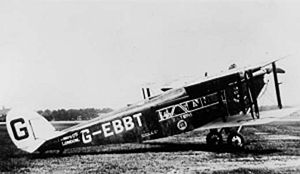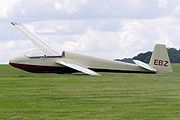
United Kingdom aircraft registration
Encyclopedia


Aircraft registration
An aircraft registration is a unique alphanumeric string that identifies a civil aircraft, in similar fashion to a licence plate on an automobile...
starting with the prefix G-.
Registration
An aircraft registrationAircraft registration
An aircraft registration is a unique alphanumeric string that identifies a civil aircraft, in similar fashion to a licence plate on an automobile...
is a unique alphanumeric string that identifies a civil aircraft, in similar fashion to a licence plate on an automobile. In accordance with the Convention on International Civil Aviation all aircraft must be registered with a national aviation authority and they must carry proof of this registration in the form of a legal document called a Certificate of Registration at all times when in operation.
The register is maintained by the United Kingdom Civil Aviation Authority
United Kingdom Civil Aviation Authority
The Civil Aviation Authority is the public corporation which oversees and regulates all aspects of aviation in the United Kingdom. The CAA head office is located in the CAA House on Kingsway in Holborn, London Borough of Camden...
.
Temporary register 1919
Although aircraft had been flown in the United Kingdom since 1908 they were not registered and were not required to carry any external markings. The principal of registering and externally-marking aircraft had been agreed upon in 1910 at an international convention in Paris and a draft Air Navigation Order had been prepared in 1911, but was not put into force before the First World WarWorld War I
World War I , which was predominantly called the World War or the Great War from its occurrence until 1939, and the First World War or World War I thereafter, was a major war centred in Europe that began on 28 July 1914 and lasted until 11 November 1918...
.
With the end of the First World War the Air Navigation Regulations came into force on 20 April 1919, allowing civil flying to commence on 1 May 1919. The regulation stated that all aircraft must carry registration marks and any passenger-carrying aircraft must have a certificate of airworthiness
Airworthiness certificate
A Certificate of Airworthiness , or an airworthiness certificate, is issued for an aircraft by the national aviation authority in the state in which the aircraft is registered. The airworthiness certificate attests that the aircraft is airworthy insofar as the aircraft conforms to its type design...
. The International Air Navigation Conference in Paris had not concluded, so a temporary system was started; former military aircraft would retain military serials
United Kingdom military aircraft serials
In the United Kingdom to identify individual aircraft, all military aircraft are allocated and display a unique serial number. A unified serial number system, maintained by the Air Ministry , and its successor the Ministry of Defence , is used for aircraft operated by the Royal Air Force , Fleet...
and any new or re-built aircraft would be registered in a sequence starting with K-100. The first civil flight under the new regulations took place on 1 May 1919 when a de Havilland DH.9 of Aircraft Transport and Travel
Aircraft Transport and Travel
Aircraft Transport and Travel Limited was a British airline formed during the First World War, a subsidiary of Airco. It was the first airline to operate a regular international flight .-History:...
flew from Hounslow to Bournemouth using former military serial C6054 as an identity. The "K series" registrations allocated were in the range K-100 to K-175, with K-169 being the highest known to have been used.
First permanent register 1919-1929
The Paris International Conference had allocated the British EmpireBritish Empire
The British Empire comprised the dominions, colonies, protectorates, mandates and other territories ruled or administered by the United Kingdom. It originated with the overseas colonies and trading posts established by England in the late 16th and early 17th centuries. At its height, it was the...
the prefix G followed by four other letters. The United Kingdom decided to use the G-Exxx sequence for heavier-than-air aircraft (for example G-EAAA) and "G-Fxxx" for lighter-than-air aircraft. The new register came into force on 22 July 1919; aircraft flying on temporary former military serials and those alloted in the K-100 sequence were all re-registered sequentially from G-EAAA.
- G-EAAA to G-EZZZ Heavier-than-air aircraft.
- G-EAAA to G-EBZZ and G-EDCA were allocated.
- G-FAAA to G-FZZZ Lighter-than-air aircraft.
- G-FAAA to G-FAAX were allocated.
- G-AUAA to G-AUZZ was allocated to Australia (1921–1929) replaced by VH-xxx.
- G-CAAA to G-CAZZ was allocated to Canada (1920–1929) replaced by CF-xxx.
- G-CYAA to G-CYZZ was allocated to Canada for government and military aircraft (1920–1929).
- G-IAAA to G-IAZZ was allocated to India (1920–1928) replaced by VT-xxx.
- G-NZAA to G-NZZZ was allocated to New Zealand (1921–1929) replaced by ZK-xxx.
- G-UAAA to G-UAZZ was allocated to the Union of South Africa (1927–1929) replaced by ZS-xxx.
Second permanent register 1928-
At the 1927 International Radio-Telegraph Conference the United Kingdom was allocated radio callsign prefixes B, G, M, VP, VQ and VR. Within this new allocation the United Kingdom continued to use the prefix G- for all aircraft but the sequence was re-started at G-AAAA, which continued into the 21st century. The first registration in the sequence, G-AAAA, was allocated to a de Havilland Gipsy MothDe Havilland DH.60 Moth
The de Havilland DH 60 Moth was a 1920s British two-seat touring and training aircraft that was developed into a series of aircraft by the de Havilland Aircraft Company.-Development:The DH 60 was developed from the larger DH 51 biplane...
, registered on 30 July 1928 to Geoffrey de Havilland
Geoffrey de Havilland
Captain Sir Geoffrey de Havilland, OM, CBE, AFC, RDI, FRAeS, was a British aviation pioneer and aircraft engineer...
. At first the registrations were issued in sequential alphabetical order but since the 1970s any four-letter combination is used. Countries in the British Empire that had used the G- prefix were allocated new two-letter allocations.
The oldest flyable aircraft in the world as of 2011, a Humber-built Bleriot XI
Blériot XI
The Blériot XI is the aircraft in which, on 25 July 1909, Louis Blériot made the first flight across the English Channel made in a heavier-than-air aircraft . This achievement is one of the most famous accomplishments of the early years of aviation, and not only won Blériot a lasting place in...
from 1909 owned by the Shuttleworth Collection
Shuttleworth Collection
The Shuttleworth Collection is an aeronautical and automotive museum located at the Old Warden airfield in Bedfordshire, England. It is one of the most prestigious in the world due to the variety of old and well-preserved aircraft.- History :...
in the UK, still uses the very early form registration G-AANG.
Microlights
From 1981 most microlights were registered in the G-MBAA/MZZZ sequence but when that had been exhausted in 1998 microlights were registered with any unused suffix.Gliders
In 1937 the sequence G-GAAA to G-GAAE was used for five gliders to operate in an international competition in Germany.From 1930 to 2003, other than aircraft required to fly outside of the United Kingdom, gliders did not need to be registered in the G- sequence but on a separate register held by the British Gliding Association. The register started with BGA.101 and sequenced upward in numerical order. The identity was not always marked externally as competition numbers were often used instead. Although competition numbers could be any alpha-numeric characters a three-letter code (called a trigraph) were used to align with the BGA number and this started with the lowest numbered glider still extant, BGA231 a Abbott-Baynes Scud II, being "AAA".
From 2003, following a ruling by the European Aviation Safety Agency
European Aviation Safety Agency
The European Aviation Safety Agency is an agency of the European Union with offices in Cologne, Germany, which has been given regulatory and executive tasks in the field of civilian aviation safety. It was created on 15 July 2002, and it reached full functionality in 2008, taking over functions...
, all gliders are now registered and marked externally in the G-xxxx sequence.
Concorde
A special sequence was allocated for ConcordeConcorde
Aérospatiale-BAC Concorde was a turbojet-powered supersonic passenger airliner, a supersonic transport . It was a product of an Anglo-French government treaty, combining the manufacturing efforts of Aérospatiale and the British Aircraft Corporation...
aircraft to allow the use of the aircraft on internal services in the United States by Branniff. For example the former G-BOAC was re-registered as G-N81AC so on arrival at Washington-Dallas the "G" could be covered up and the United States registration N81AC could be used for internal flights.

